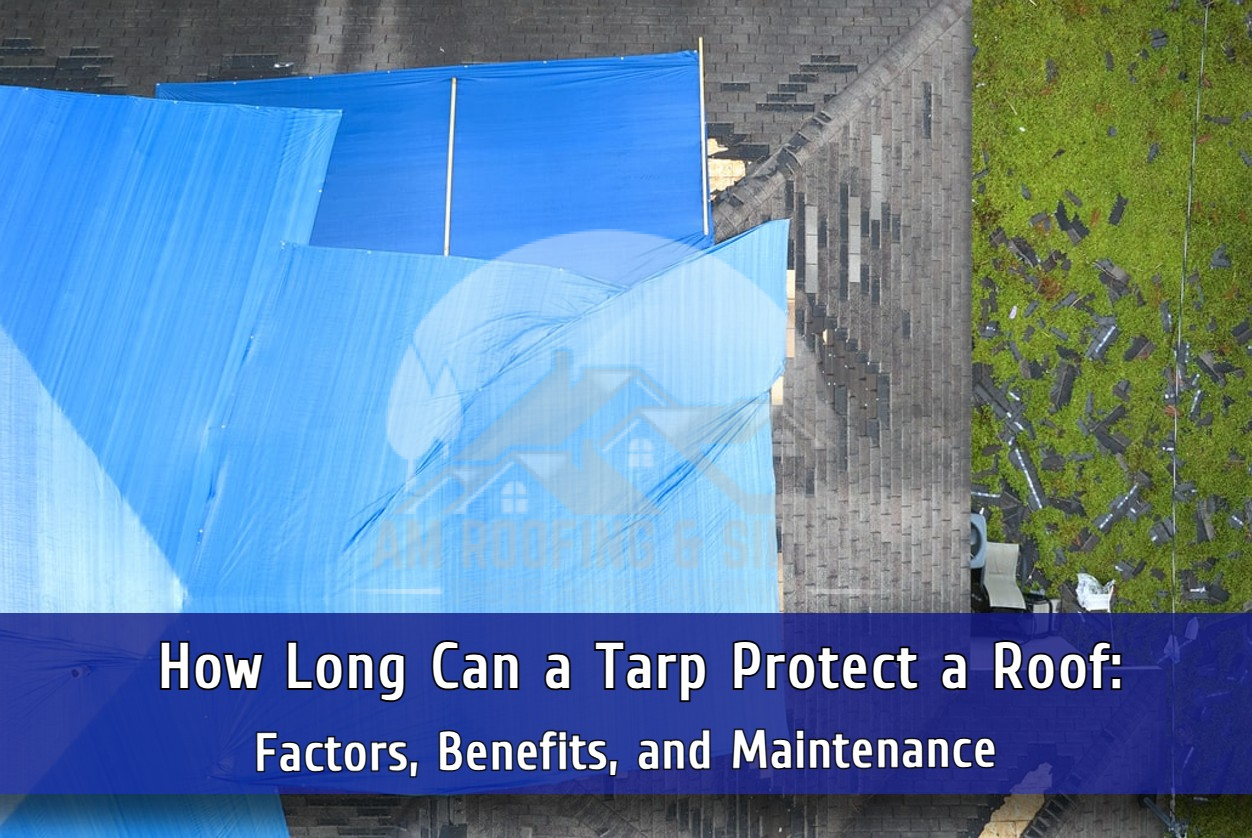When unexpected roof damage occurs, homeowners often turn to temporary solutions to protect their property from further harm. One of the most common and effective short-term measures is the use of a tarp. If you’re wondering “how long can a tarp protect a roof?”, you’re not alone. This crucial question concerns many, especially following severe weather events that can strike the Central Ohio area. Tarps serve as a vital barrier against the elements, but their durability and effectiveness depend on several factors.
The lifespan of a temporary roof tarp can vary. Several elements such as material quality, weather conditions, and the method of installation play pivotal roles in determining how long a tarp can effectively cover and protect a roof. Typically, a well-secured tarp can last anywhere from a few weeks to several months. Understanding the right techniques for emergency roof tarp installation and choosing the best tarps for roof damage protection are essential to maximizing this timeframe.
This section will explore the factors influencing a tarp’s functional duration and provide insights on securing a tarp on a leaky roof. By the end of this discussion, you will have a clearer understanding of how to effectively use tarps for roof protection and extend their usefulness until permanent repairs can be made.
The Benefits of Using Tarps for Roof Protection
Deploying tarps for emergency roof coverage offers immediate advantages, particularly in the aftermath of storms or unexpected roofing damage. Tarps are not only readily available but also cost-effective, making them an excellent first line of defense against the elements. This quick and efficient method helps homeowners in Central Ohio protect their properties from water intrusion, which can lead to more severe structural issues if left unaddressed.
The use of tarps can substantially reduce the potential for further damage, effectively minimizing the scope and cost of subsequent repairs. By covering exposed areas of a roof, tarps prevent the accumulation of water and the infiltration of debris, both of which can exacerbate the damage and increase repair costs. In the short term, a securely installed tarp can create a barrier that wards off additional moisture and protects the roof structure until professional repairs can be undertaken.
Understanding how to secure a tarp on a leaky roof is crucial for ensuring the tarp’s effectiveness. Proper installation not only enhances the tarp’s protective qualities but also extends its lifespan, making it a reliable temporary solution. Emergency roof tarp installation tips, such as ensuring the tarp covers the damaged area completely and is adequately anchored, can make a significant difference in the level of protection provided.
Selecting the Right Tarp for Your Roof
Choosing the appropriate tarp for roof protection is critical, especially when dealing with the unpredictable weather in Central Ohio. Tarps come in various materials and strengths, each suited to different types of roofing emergencies. Polyethylene tarps are popular due to their waterproof and tear-resistant properties, making them ideal for temporary roof tarp applications.
When selecting a tarp, it is important to consider factors like material durability and weather resistance. A heavy-duty tarp made from high-density polyethylene or canvas can offer better protection and a longer temporary roof tarp lifespan. These materials are designed to withstand harsh conditions, such as heavy rains, strong winds, and prolonged exposure to sunlight, which are common in emergency scenarios.
The benefits of using tarps for roof protection include quick deployment and cost-effectiveness, but choosing the right tarp is essential to maximize these advantages. For instance, reinforced corners and rust-resistant grommets can enhance a tarp’s durability and effectiveness in securing it over a leaky roof. By selecting the best tarps for roof damage protection, homeowners can ensure that their temporary solution holds up until professional repairs can be made.
Key Considerations For Securing a Tarp on a Leaky Roof
Securing a tarp on a leaky roof requires careful consideration to ensure it provides maximum protection. When installing a tarp, particularly in areas prone to erratic weather like Central Ohio, it’s crucial to assess both the material and the method of installation. The goal is to maintain the integrity of the roof for as long as possible, minimizing any further damage.
First, ensure that the tarp covers the entire damaged area adequately. It should extend beyond the damaged zones to prevent any water from leaking into the roof’s undamaged parts. Securing the tarp involves using sturdy, weather-resistant ropes or bungee cords. The tarp should be anchored to stable structures on the roof or the building itself.
Additionally, using sandbags or weights along the edges of the tarp can help prevent it from flapping, which could lead to wear and tear or the tarp being blown away. This method is particularly effective in safeguarding against the elements and ensuring the tarp remains in place. By following these tips on how to secure a tarp on a leaky roof, homeowners can effectively shield their property from immediate water damage and provide a temporary solution until professional help arrives.
Maintenance Tips for Prolonging Tarp Effectiveness
Regular maintenance and checks are crucial for extending the life of a temporary roof tarp and ensuring it continues to provide adequate protection. It is recommended to inspect the tarp regularly, especially after severe weather events, which are common in Central Ohio. Look for signs of wear such as tears, holes, or thinning materials, which can compromise the tarp’s ability to protect the roof.
Common issues with prolonged tarp use include loosening of its securement points and water accumulation, leading to pooling that can stress the material. To address these challenges, ensure that the tarp is tightly secured and check the tension frequently. If sagging or pooling is observed, reposition the tarp to allow water to run off smoothly. Additionally, clearing debris from the tarp regularly can prevent punctures or accumulation that could weigh down the tarp and cause damage.
Ultimately, while a temporary roof tarp can offer immediate and effective protection, understanding how to maintain and inspect the tarp can significantly impact its lifespan and functionality. These maintenance tips will help ensure that your tarp continues to protect your roof from weather-induced damages until permanent repairs are carried out.
When to Replace Your Roof Tarp
Knowing when to replace your roof tarp is crucial for maintaining effective roof protection. Over time, tarps can degrade and lose their ability to shield your home from the elements. Recognizing the indicators that suggest your tarp needs replacement can save you from potential damage and costly repairs.
Signs of wear and tear on a tarp include noticeable holes, thinning material, or frayed edges. If you observe any of these issues, it’s likely time to consider a new tarp. Additionally, if the tarp no longer repels water effectively, allowing moisture to seep through, this is a clear signal that the tarp’s functionality is compromised. Regular inspections after major weather events can help identify these issues early, ensuring your roof remains protected.
It’s also important to monitor how securely the tarp is fastened. A tarp that frequently needs re-securing or has torn loose from its anchor points may require replacement. Ensuring your tarp is properly installed with adequate coverage and secure fastening will extend its lifespan and effectiveness in protecting your roof from further damage.
Ultimately, while tarps are an excellent temporary solution for roof protection, they are not meant to replace permanent roofing repairs. If your tarp has been in place for an extended period, consulting with a professional for a comprehensive roof inspection and necessary repairs is advisable.
Local Considerations for Roof Tarps in Central Ohio
In Central Ohio, the climate poses unique challenges that can affect the longevity and effectiveness of roof tarps. The region experiences a wide range of weather conditions, from harsh winters with heavy snowfall to humid summers accompanied by thunderstorms. These elements can significantly influence how long a tarp can protect a roof.
For residents of Central Ohio, selecting a roof tarp that can withstand frequent temperature fluctuations and severe weather events is crucial. It’s important to choose tarps made from durable materials such as polyethylene or canvas, which are known for their resistance to water, UV rays, and tears. Additionally, ensuring that the tarp is properly secured is vital, as strong winds can easily dislodge poorly anchored tarps, leading to potential roof damage.
Emergency Roof Tarping in Central Ohio
For reliable roof protection, trust AM Roofing & Siding. Call us at (740) 974-8268 to secure your home from leaks and damage. Our expert team understands the challenges of Central Ohio’s climate and can guide you in choosing the right tarp for your roof. Don’t wait until it’s too late – take proactive steps to safeguard your home today. Reach out to AM Roofing & Siding for professional advice and top-notch service.

